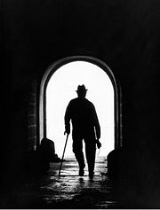
Contre-jour
Encyclopedia
Contre-jour, French
for 'against daylight
', refers to photograph
s taken when the camera
is pointing directly toward a source of light. An alternative term is backlighting
.
Contre-jour produces backlighting of the subject. This effect usually hides details, causes a stronger contrast between light and dark, creates silhouette
s and emphasizes lines and shapes. The sun
, or other light source, is often seen as either a bright spot or as a strong glare behind the subject. Fill light
may be used to illuminate the side of the subject facing toward the camera. Silhouetting occurs when there is a lighting ratio
of 16:1 or more; at lower ratios such as 8:1 the result is instead called low-key lighting
.
French language
French is a Romance language spoken as a first language in France, the Romandy region in Switzerland, Wallonia and Brussels in Belgium, Monaco, the regions of Quebec and Acadia in Canada, and by various communities elsewhere. Second-language speakers of French are distributed throughout many parts...
for 'against daylight
Daylight
Daylight or the light of day is the combination of all direct and indirect sunlight outdoors during the daytime. This includes direct sunlight, diffuse sky radiation, and both of these reflected from the Earth and terrestrial objects. Sunlight scattered or reflected from objects in outer space is...
', refers to photograph
Photograph
A photograph is an image created by light falling on a light-sensitive surface, usually photographic film or an electronic imager such as a CCD or a CMOS chip. Most photographs are created using a camera, which uses a lens to focus the scene's visible wavelengths of light into a reproduction of...
s taken when the camera
Camera
A camera is a device that records and stores images. These images may be still photographs or moving images such as videos or movies. The term camera comes from the camera obscura , an early mechanism for projecting images...
is pointing directly toward a source of light. An alternative term is backlighting
Backlighting (lighting design)
Backlighting refers to the process of illuminating the subject from the back. In other words, the lighting instrument and the viewer are facing towards each other, with the subject in between. This causes the edges of the subject to glow, while the other areas remain darker. The backlight can be a...
.
Contre-jour produces backlighting of the subject. This effect usually hides details, causes a stronger contrast between light and dark, creates silhouette
Silhouette
A silhouette is the image of a person, an object or scene consisting of the outline and a basically featureless interior, with the silhouetted object usually being black. Although the art form has been popular since the mid-18th century, the term “silhouette” was seldom used until the early decades...
s and emphasizes lines and shapes. The sun
Sun
The Sun is the star at the center of the Solar System. It is almost perfectly spherical and consists of hot plasma interwoven with magnetic fields...
, or other light source, is often seen as either a bright spot or as a strong glare behind the subject. Fill light
Fill light
In television, film, stage, or photographic lighting, a fill light may be used to reduce the contrast of a scene and provide some illumination for the areas of the image that are in shadow...
may be used to illuminate the side of the subject facing toward the camera. Silhouetting occurs when there is a lighting ratio
Lighting ratio
Lighting ratio in photography refers to the comparison of key light to the fill light . The higher the lighting ratio, the higher the contrast of the image; the lower the ratio, the lower the contrast.Light can be measured in footcandles...
of 16:1 or more; at lower ratios such as 8:1 the result is instead called low-key lighting
Low-key lighting
Low-key lighting is a style of lighting for photography, film or television. It is a necessary element in creating a chiaroscuro effect. Traditional photographic lighting, three-point lighting uses a key light, a fill light, and a back light for illumination...
.
See also
- High dynamic range imagingHigh dynamic range imagingIn image processing, computer graphics, and photography, high dynamic range imaging is a set of techniques that allows a greater dynamic range between the lightest and darkest areas of an image than current standard digital imaging techniques or photographic methods...

